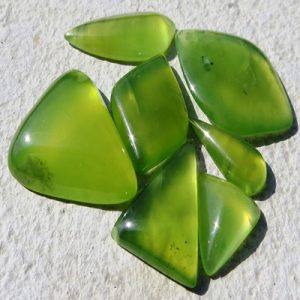Californite
Californite, also known as varies name like California Jade, American Jade or Vesuvianite Jade or idocrase, is a rare variety of Vesuvianite that is only found in California. This bright green translucent to opaque material comes from several locations in and around Happy Camp, Siskiyou County; at the Pulga deposit, Butte County; and at Sky Blue Hill, Crestmore, Riverside County, California, USA. It is usually found as opaque, massive material suitable for cabochons, rarely as facet grade crystals. The cabochons are very attractive and look very similar to Jade. Faceted gems are usually translucent and silky and may resemble green Prehnite. Vesuvianite (also known as Idocrase) is found in colors ranging from green to brown and rarely blue (Cyprine).
| Category: | Sorosilicate |
| Chemical Formula: | Ca10(Mg, Fe)2Al4(SiO4)5(Si2O7)2(OH,F)4 |
| Calcium Aluminum Iron Silicate | |
| Molecular Weight: | 1,422.09 gm |
| Composition: | Calcium | 28.18 % | Ca | 39.43 % | CaO |
| Magnesium | 3.42 % | Mg | 5.67 % | MgO | |
| Aluminum | 7.59 % | Al | 14.34 % | Al2O3 | |
| Silicon | 17.77 % | Si | 38.03 % | SiO2 | |
| Hydrogen | 0.28 % | H | 2.53 % | H2O | |
| Oxygen | 42.75 % | O | |||
| 100.00 % | 100.00 % | = TOTAL OXIDE |
| Crystallography: | Tetragonal – Dipyramidal |
| Crystal Habit: | Vesuvianite: Crystals commonly as short pyramidal to long prismatic crystals, to 15 cm, morphologically complex, with up to 30 forms reported on one crystal; columnar, granular, massive. Californite is found in massive form, not as crystals. |
| Twinning: | Vesuvianite: Twinned domains observed at a very fine scale. |
| Cleavage: | Indistinct on {110}, {100} and {001] |
| Fracture: | Irregular/Uneven, Sub-conchoidal |
| Tenacity: | Brittle |
| Moh’s Hardness: | 6.5 – 7.0 |
| Density: | 3.32 – 3.47 (g/cm3) |
| Luminescence: | None |
| Radioactivity: | Not Radioactive |
| Color: | Green, Yellowish Green |
| Transparency: | Transparent, Translucent, Opaque |
| Luster: | Vitreous, Resinous |
| Refractive Index: | 1.700 to 1.725 Uniaxial ( -/+ ) and Biaxial |
| Birefringence: | 0.0040 – 0.0060 |
| Dispersion: | Strong; 0.019 – 0.025 |
| Pleochroism: | Weak; O = colorless to yellowish, E = yellowish, greenish, brownish |


